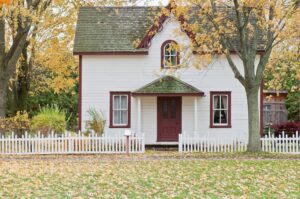Frequently Asked Questions About Roof Discoloration

A residential roof doesn’t just play a critical role in protecting your home and its occupants against foul weather — it also enhances your home’s aesthetics, from the architectural style to the color scheme. You might feel understandably dismayed, then, to discover if your roof has developed an unsightly discoloration.
While you may know what to do about straightforward structural problems such as damaged shingles or evident leaks, a discolored roof can leave you scratching your head about what happened and how you should respond. The answers to the following frequently asked questions can set you on the right path toward repairs.
Why Do Streaks Develop on Asphalt Roofs?
Asphalt roofs in humid parts of the country can foster algae growth over time. Roofs plagued with this problem will develop dark-brown or dark-green streaks that may extend from the top of the roof to the edge. Roofs that get lots of shade and retain moist spots may prove especially vulnerable to algae discoloration.Another kind of discoloration may occur if the original roof installation used subpar materials. For instance, defective manufacturing techniques can fail to cure the shingles properly, allowing the asphalt pigments to spread out onto neighboring shingles. Roofers refer to this problem as extractive bleed-through.
Even accumulations of everyday debris can discolor your asphalt roof. Leaves, dirt, chimney ash, and other debris can cause dark stains to form over time. You can identify this problem by its location and distribution, such as discolored areas of the roof that commonly get covered with leaves or stains around the chimney flashing.
What Kinds of Discoloration Can Clay Tile Roofs Develop?
Clay tile roofs can get stains by organic and inorganic debris just as asphalt shingle roofs can. Natural clay tiles can also develop mold or algae infestations, defacing their rich red or orange hues with dark, ugly stains. Clay tiles that lack proper sealing may turn into dirt and debris magnets.
Efflorescence presents another problem for clay tile roof owners. This problem involves reactions between the lime in the clay, rainwater, and the atmosphere. These interactions create white spots, streaks, and other light-colored marks.
Why Do Metal Roofs Experience Discoloration?
Along with the dirt and debris mentioned above, metal roofs can fall prey to rust, especially if their protective layer of paint has sustained scratches or chips that allow water and air to corrode the underlying material. This corrosion can produce patches or red or brown discoloration that grow steadily larger over time.
Some metal roofs resist corrosion and rust better than others. For instance, aluminum offers excellent rust resistance, although it can corrode in different ways. Copper roofs won’t rust, but exposure to air and water will cause them to change colors as they develop an outer covering called a patina.
How Can Roofing Technicians Fix Your Discolored Roof?
An experienced roofing technician can use pressure washers and other equipment to clean away dirt and algae. These experts know how to clean delicate materials like asphalt and clay tile without damaging them. With luck, some professional cleaning will restore your roof to its previous beauty.
Rust in metal roofing presents more of a concern since this kind of degeneration can weaken the metal or even eat holes through it if it goes unchecked. Your roofing technician can remove the rust before it reaches this stage and add a fresh coat of rust-resistant paint.
If you can’t stand the thought of looking at a discolored roof for many years to come, contact Rays Harford Home Improvement Contractors, Inc. We can examine the problem, root out the cause of the discoloration, and discuss your roof replacement or repair options with you in detail. Request an estimate today.

